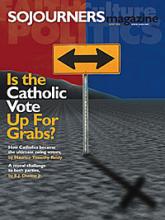The strange thing is that the “Catholic Vote” doesn’t exist. Catholics are the largest single religious group in the United States. They—we—vote in large numbers. We are terribly important to the outcome of elections. But we do not vote as a bloc. The extent to which Catholics ever did vote as a bloc has been exaggerated. In the two presidential elections of the 1950s, for example, Catholics split roughly evenly between Dwight Eisenhower and Adlai Stevenson.
As Tim Reidy suggests in this issue, Catholics have been a competitive group since 1968. Catholics and Mainline Protestants are the two great “swing” religious constituencies in American politics. Mainline Protestants are a swing constituency because they are less Republican than they once were, Catholics because they are less Democratic. Roughly 40 percent of Catholics are reliably Republican. A comparable group is reliably Democratic. The rest move around.
Just contemplate these names: Ted Kennedy, Mario Cuomo, Bob Casey, Richard Neuhaus, Peter and Peggy Steinfels, Rick Santorum, Bill Bennett. All are Catholics, but there is enormous disagreement within this group on and around election time. This year, Santorum and Casey are running against each other for one of Pennsylvania’s seats in the U.S. Senate.
Argument among Catholics is normal because the church’s formal political positions, largely consistent over the last 30 years, do not map neatly with those of our political parties or our conventional ideologies. The Catholic Church is strongly opposed to abortion, stem cell research, assisted suicide, and gay marriage. It is also strongly opposed to the death penalty, skeptical of an interventionist foreign policy, committed to a substantial government role in fighting poverty, and wary of unregulated capitalism.
Read the Full Article

